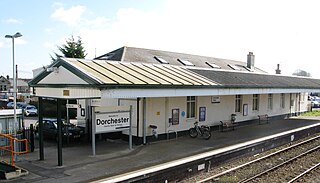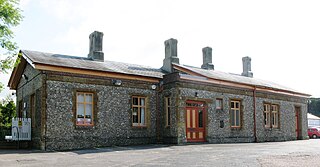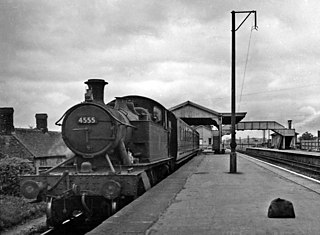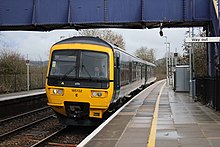
Exeter St Davids railway station is the principal and largest railway station in Exeter, also the second-busiest station in Devon.

Cheltenham Spa railway station serves the spa town of Cheltenham in Gloucestershire, England. Situated on the Bristol–Birmingham main line, it is managed by Great Western Railway, although most services are operated by CrossCountry. The station is about one mile from the town centre. The official name of the station is Cheltenham, however when the station was renamed in 1925, the London, Midland and Scottish Railway chose to add Spa to the station name. It is a regional interchange and the busiest station in Gloucestershire, as well as one of the busiest railway stations in South West England.

Gloucester, formerly known as Gloucester Central, is a railway station serving the city of Gloucester in England. It is located 114 miles 4 chains (183.5 km) west of London Paddington, via Stroud.

Yeovil Pen Mill is one of two railway stations that serve the town of Yeovil, Somerset, England. It is situated just under a mile to the east of the town centre. The station is located 59.5 miles (96 km) south of Bristol Temple Meads, on the Heart of Wessex Line. It is managed by Great Western Railway, who operate services along with South Western Railway.

Totnes railway station serves the town of Totnes in Devon, England. It was opened by the South Devon Railway Company in 1847. Situated on the Exeter to Plymouth Line, it is located 222 miles 66 chains down the line from London Paddington via Box.

Dorchester West is one of two railway stations that serve the town of Dorchester in Dorset, England, the other is Dorchester South. It is managed by Great Western Railway, which also operates all services that stop here. The station is located on the Heart of Wessex Line between Castle Cary and Weymouth, at the southern end of a single track section from Maiden Newton. It is sited 161.63 mi (260.12 km) from London Paddington, via Swindon and Westbury. The line becomes double at the station and remains so to just before nearby Dorchester Junction, where the line joins the South West Main Line from London Waterloo to Weymouth.

Maiden Newton railway station is a railway station serving the village of Maiden Newton in Dorset, England. The station is located on the Heart of Wessex Line, 154.12 miles from the zero point at London Paddington, measured via Swindon and Westbury.

Westbury railway station serves the market town of Westbury in Wiltshire, England. The station is managed by Great Western Railway.

Swindon railway station is on the Great Western Main Line in South West England, serving the town of Swindon, Wiltshire. The station is 77 miles 23 chains down the line from the zero point at London Paddington and lies between Didcot Parkway and Chippenham. It is managed by Great Western Railway, which also operates all of the services from the station. It is the busiest station in Wiltshire, and the fifth busiest station in South West England.

Bruton railway station serves a largely rural area in the county of Somerset in England. The station is situated in the market town of Bruton. The station is on the Bristol to Weymouth line some 32.75 miles (53 km) south of Bath Spa. Trains on the Reading to Taunton line pass through the station but do not normally stop. Services are operated by Great Western Railway and South Western Railway.

St Austell station is a Grade II listed station which serves the town of St Austell, Cornwall, England. It is 286 miles 26 chains from the zero point at London Paddington measured via Box and Plymouth Millbay. The station is operated by Great Western Railway.

Redruth station serves the town of Redruth, Cornwall, United Kingdom; it is situated on the Cornish Main Line between Truro and Camborne. The station is 309 miles 68 chains down the line from the zero point at London Paddington, measured via Box and Plymouth Millbay.

Witham (Somerset) railway station was a station serving the Somerset village of Witham Friary and was located on the Frome to Yeovil section of the Wilts, Somerset and Weymouth Railway that opened in 1856.

Melksham railway station serves the town of Melksham in Wiltshire, England. It is 100 miles 13 chains measured from London Paddington, on the TransWilts Line between Chippenham and Trowbridge that was originally part of the Wilts, Somerset and Weymouth Railway, absorbed in 1850 by the Great Western Railway.
The Cheddar Valley line was a railway line in Somerset, England, running between Yatton and Witham. It was opened in parts: the first section connecting Shepton Mallet to Witham, later extended to Wells, was built by the East Somerset Railway from 1858. Later the Bristol and Exeter Railway built their branch line from Yatton to Wells, but the two lines were prevented for a time from joining up. Eventually the gap was closed, and the line became a simple through line, operated by the Great Western Railway.

Frome railway station serves a largely rural area of the county of Somerset in England, and is situated in the town of Frome. The station is located on a 1.5 miles (2.4 km) long branch line which loops off the main line railway, which carries services on both the Reading to Taunton line and Bristol to Weymouth route. Most of the trains which take the loop line in order to serve Frome station are on the Bristol to Weymouth route, and most trains on the Reading to Taunton line by-pass the station on the main line. The station is 22.25 miles (36 km) south of Bath Spa on the Bristol to Weymouth line, it is owned by Network Rail and is operated by Great Western Railway.
The Wilts, Somerset and Weymouth Railway (WS&WR) was an early railway company in south-western England. It obtained Parliamentary powers in 1845 to build a railway from near Chippenham in Wiltshire, southward to Salisbury and Weymouth in Dorset. It opened the first part of the network but found it impossible to raise further money and sold its line to the Great Western Railway (GWR) in 1850.
The Langport and Castle Cary Railway is a railway line from Castle Cary railway station to Cogload Junction near Taunton, Somerset, England, which reduced the length of the journey from London to Penzance by 20+1⁄4 miles (32.6 km).
The Stert and Westbury Railway was opened by the Great Western Railway Company in 1900 in Wiltshire, England. It shortened the distance between London Paddington station and Weymouth, and since 1906 has also formed part of the Reading to Taunton line for a shorter journey from London to Penzance.

The Reading–Taunton line is a major branch of the Great Western Main Line from which it diverges at Reading railway station. It runs to Cogload Junction where it joins the Bristol to Exeter and Penzance line.


















